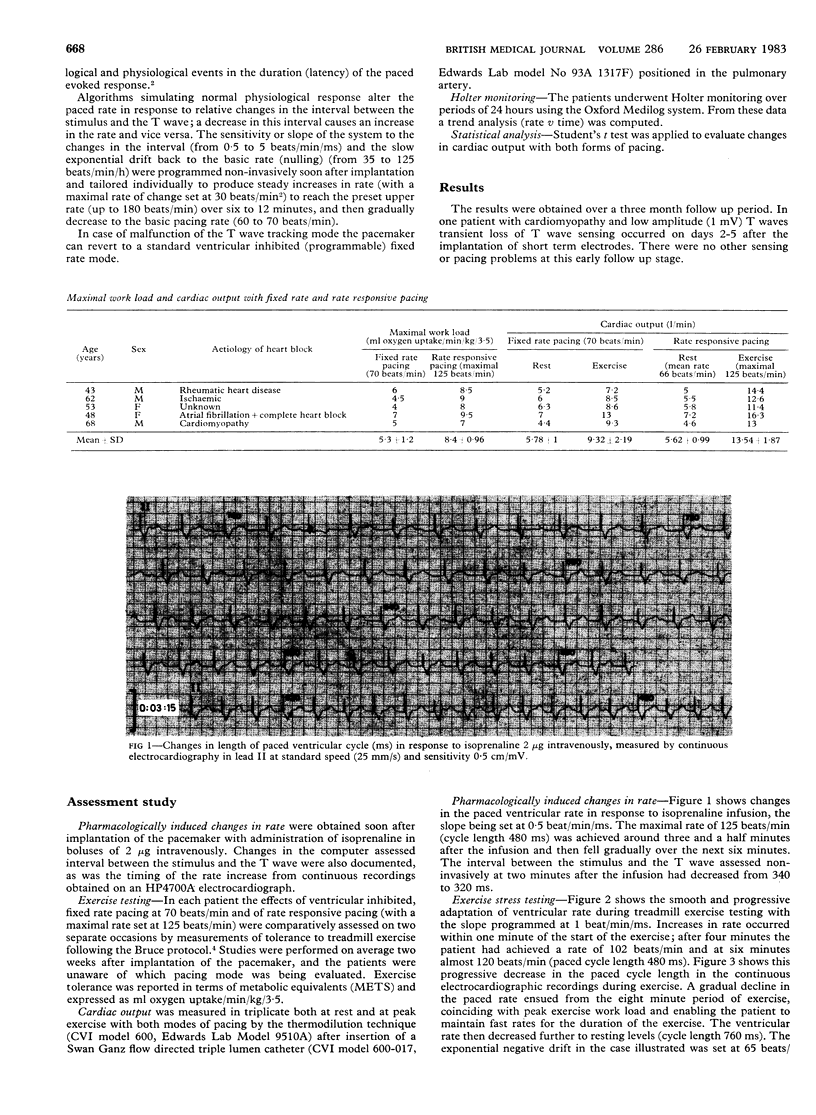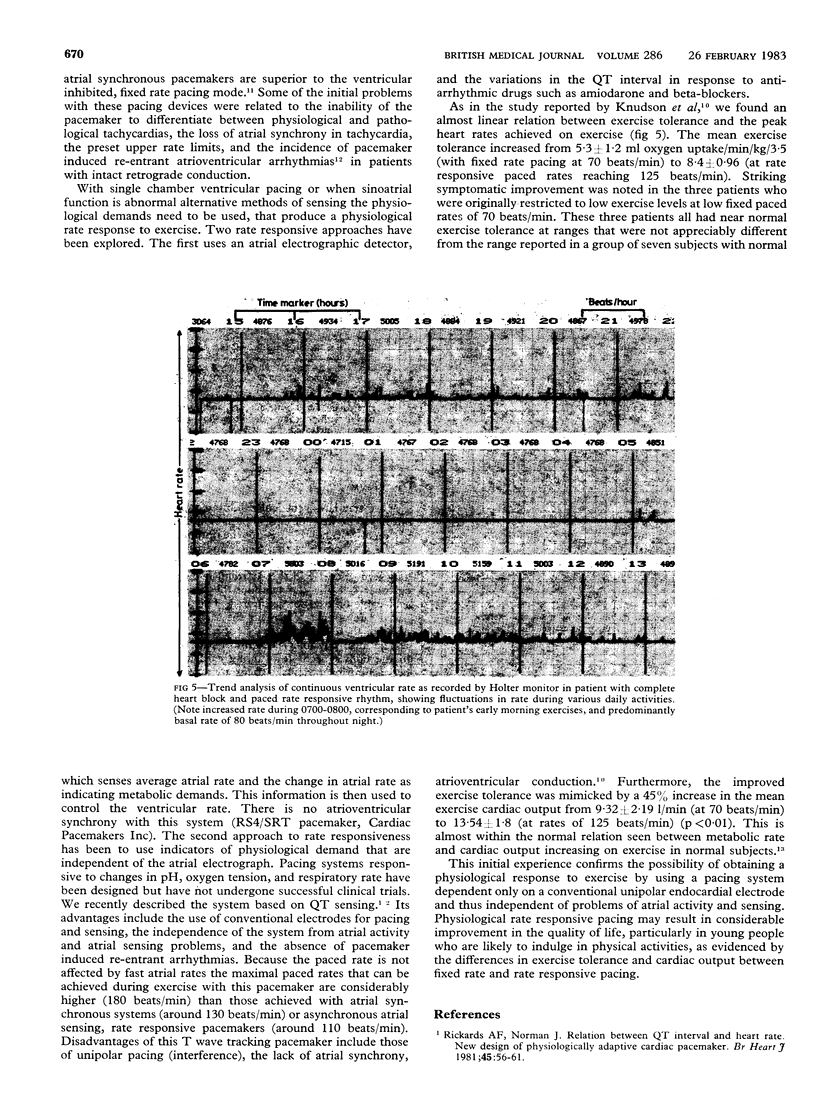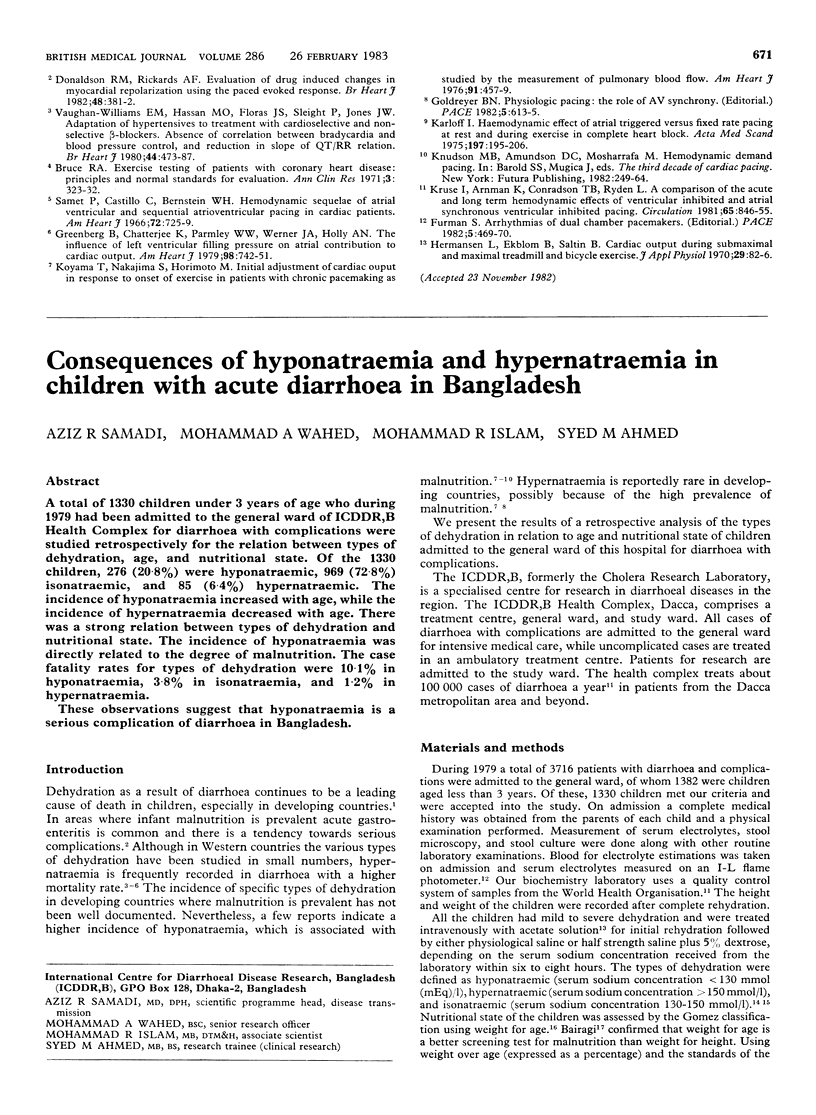Abstract
A new pacemaker that can adapt the heart rate in response to the patient's metabolic requirements has been developed. This pacemaker uses the QT interval as the indicator of physiological demand. Experience in five patients showed the rate response to exercise to be smooth and progressive and to return gradually to the basic paced rate after activity stopped. Physiological rate responsive pacing resulted in a 45% increase in cardiac output when compared with fixed rate pacing. Similarly, a 57% increase in maximal exercise capacity was noted when rate responsive pacing was compared with conventional pacing at 70 beats/min. This study showed that physiological rate responsive pacing using the QT interval provides a simple means of increasing the heart rate in accordance with the body's requirements.
Full text
PDF




Images in this article
Selected References
These references are in PubMed. This may not be the complete list of references from this article.
- Bruce R. A. Exercise testing of patients with coronary heart disease. Principles and normal standards for evaluation. Ann Clin Res. 1971 Dec;3(6):323–332. [PubMed] [Google Scholar]
- Donaldson R. M., Rickards A. F. Evaluation of drug-induced changes in myocardial repolarisation using the paced evoked response. Br Heart J. 1982 Oct;48(4):381–387. doi: 10.1136/hrt.48.4.381. [DOI] [PMC free article] [PubMed] [Google Scholar]
- Goldreyer B. N. Physiologic pacing: the role of AV synchrony. Pacing Clin Electrophysiol. 1982 Jul;5(4):613–615. doi: 10.1111/j.1540-8159.1982.tb02288.x. [DOI] [PubMed] [Google Scholar]
- Greenberg B., Chatterjee K., Parmley W. W., Werner J. A., Holly A. N. The influence of left ventricular filling pressure on atrial contribution to cardiac output. Am Heart J. 1979 Dec;98(6):742–751. doi: 10.1016/0002-8703(79)90473-3. [DOI] [PubMed] [Google Scholar]
- Hermansen L., Ekblom B., Saltin B. Cardiac output during submaximal and maximal treadmill and bicycle exercise. J Appl Physiol. 1970 Jul;29(1):82–86. doi: 10.1152/jappl.1970.29.1.82. [DOI] [PubMed] [Google Scholar]
- Karlöf I. Haemodynamic effect of atrail triggered versus fixed rate pacing at rest and during exercise in complete heart block. Acta Med Scand. 1975 Mar;197(3):195–206. [PubMed] [Google Scholar]
- Koyama T., Nakajima S., Horimoto M. Initial adjustment of cardiac output in response to onset of exercise in patients with chronic pacemaking as studied by the measurement of pulmonary blood flow. Am Heart J. 1976 Apr;91(4):457–459. doi: 10.1016/s0002-8703(76)80327-4. [DOI] [PubMed] [Google Scholar]
- Kruse I., Arnman K., Conradson T. B., Rydén L. A comparison of the acute and long-term hemodynamic effects of ventricular inhibited and atrial synchronous ventricular inhibited pacing. Circulation. 1982 May;65(5):846–855. doi: 10.1161/01.cir.65.5.846. [DOI] [PubMed] [Google Scholar]
- Rickards A. F., Norman J. Relation between QT interval and heart rate. New design of physiologically adaptive cardiac pacemaker. Br Heart J. 1981 Jan;45(1):56–61. doi: 10.1136/hrt.45.1.56. [DOI] [PMC free article] [PubMed] [Google Scholar]
- Samet P., Castillo C., Bernstein W. H. Hemodynamic sequelae of atrial, ventricular, and sequential atrioventricular pacing in cardiac patients. Am Heart J. 1966 Dec;72(6):725–729. doi: 10.1016/0002-8703(66)90154-2. [DOI] [PubMed] [Google Scholar]
- Williams E. M., Hassan M. O., Floras J. S., Sleight P., Jones J. V. Adaptation of hypertensives to treatment with cardioselective and non-selective beta-blockers. Absence of correlation between bradycardia and blood pressure control, and reduction in slope of the QT/RR relation. Br Heart J. 1980 Nov;44(5):473–487. doi: 10.1136/hrt.44.5.473. [DOI] [PMC free article] [PubMed] [Google Scholar]





